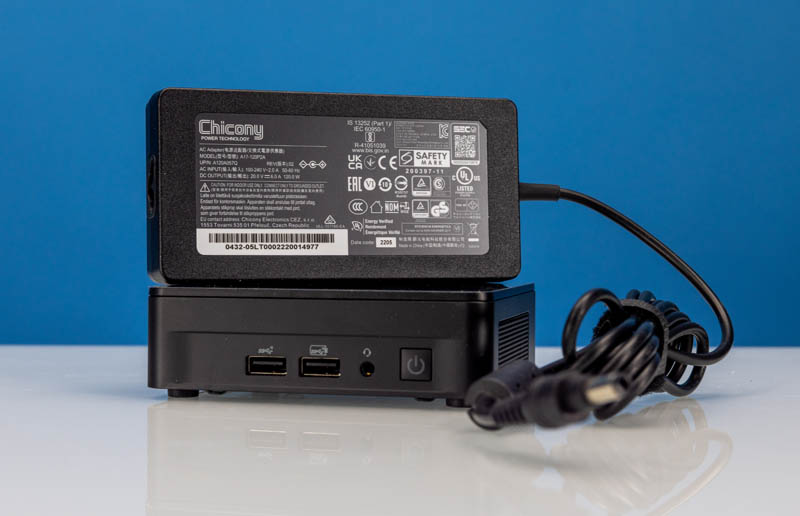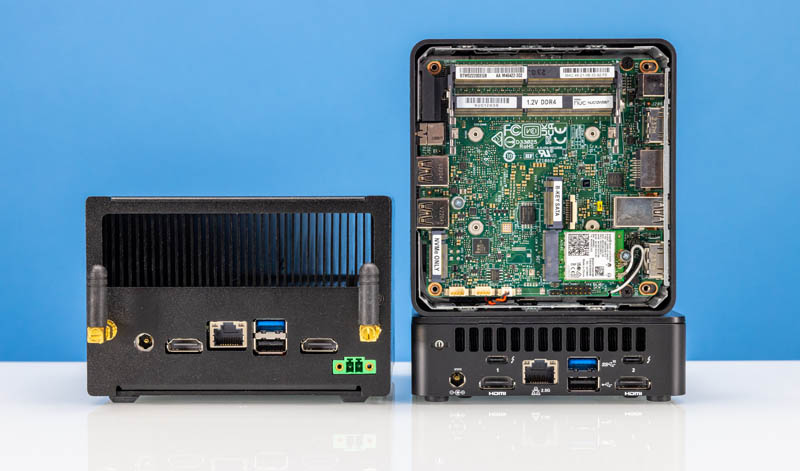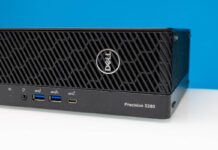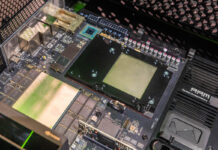Intel NUC 12 Pro “Wall Street Canyon” Power Consumption and Noise
Powering the unit is a 120W external power adapter. Something that is common on NUCs that many may not be aware of is that with all three of our NUCs, the portion that goes from a C5 connector to the wall socket is not supplied. That allows Intel to make one SKU and sell it worldwide, and the C5 to the local socket parts are generally easy to source inexpensively.

Power consumption at idle was in the 6-10W range whereas the industrial fan-less model was in the 5-8W range. Normal usage we could get the system into 40-90W depending on the task. Top-end power consumption is in the 90-101W range without attachments. We showed the unit touching just over 100W in the video.
The video also has noise levels at a number of these different points.
For the fanless unit, we did not get power above the 55-60W range, but that unit was thermal throttling.
Intel NUC 12 Pro Key Lessons Learned
The Intel Alder Lake architecture and the NUC 12 Pro is awesome. The P-core and E-core mix works great. One also gets the newer Intel Xe graphics with things like AV1 decode. AV1 is a codec not widely used today, but it is expected to be in the future so for a media streaming endpoint, that is a great feature.

We tested these units with Windows 11, Ubuntu, and Proxmox VE 7, and they performed like other Alder Lake systems. That also extends to VMware ESXi 8 where the different P-cores and E-cores present on the chip will cause a pink screen of death (PSOD) using the default installer. William Lam at VMware has the fix that you will need with these systems.

The other challenge with the units is that these are only single NIC systems. For some industrial, server, and desktop applications, having a second wired NUC, like we saw on the ASRock units, may be useful. Still, having Thunderbolt adds a world of expansion options, even if they are pricey.
Final Words
Overall, the Intel NUC 12 Pro “Wall Street Canyon” was what we expected. It is a continuation of a line that many tech enthusiasts love since it packs so many features into such a small package.

Inside the system, we can see the impact of both the new technologies with this generation along with some of Intel’s engineering. A great example is the SSD heatsink solution that so many other mini PCs lack but can often use. Having so many cores and up to 64GB of memory is awesome. That 64GB configuration is not pictured, but we tested with the 2x 32GB G.Skill units (Amazon affiliate link) we use in these PCs to validate it works.

Showing the fanless NUC was really interesting. We love fanless systems and test many of them. This one certainly made some trade-offs, but it was a decent demonstration of how others adopt the NUC platform.

Overall, the Intel NUC line is awesome. While it has expanded greatly over the years to relatively gargantuan form factors, the classic ~4.5×4.5×1.5″ box design is always our favorite. With the Intel Core i7-1260P this is also a big update over the previous generation to the magnitude we do not expect again until Meteor Lake arrives.




I’d say Intel needs to make a 50% bigger NUC just to add quieter cooling after listening to the video. That 115mm form factor isn’t cuttin’ it anymore. These are using more than twice the power of the old NUC.
Or add a big fan (would 120mm fit? Otherwise 92mm) to the fanless model and run it at very low speed. Should not be to hard to 3d print a adapter..
Small note, KC2500 is not PCI-e 4.0 but PCI-e 3.0.
‘We have a PCIe Gen4 NVMe SSD (Kingston KC2500) installed […]” should be
‘We have a PCIe Gen3 NVMe SSD (Kingston KC2500) installed […]”. Gen4 is KC3000.
“We should also quickly point out that this is an Alder Lake machine, so these will be i225 B3 parts, not the newer C stepping i226 parts with lower BER and power consumption.”
I’ve seen reports of some fairly nasty teething issues with some of the Intel 2.5GbE parts(I think it was i225 prior to B3?)
Are we at the point where, while the i226 is an improvement, any i225 or 226 that shows up in a reasonably reputable context(NUC, known-brand motherboards and laptops, etc.) can be relied on to have a non-broken stepping; or are there still units floating around that need to be specifically checked for problem parts?
fuzz everything has been B3 or later for more than a year.
I would change one USB-C for another ethernet port.
After so many NUC generations a quiet machine under “moderate” load should be mandatory. Its quiet on no load. Thats all.
And you buy “pro” and an i7 because you need “some” horsepower. A rather-silent under load NUC would be a no brainer for me. But they are not. AMD “nucs” are worse.
IMHO, the problem with NUCs is most laptops have better value on purchase and afterwards. For a hundred or so euros you have a keyboard/mouse, a display and a UPS. Which is a huge difference (vostros, thinkbooks, some latitudes, some thinkpads)
As a server are all advantages, plus you might have the option of a GPU, usefull for some loads.
As a office-desktop machine as well. Maybe you save some space if its mounted rear a display…
Thank you Michael – I was recording a video with a different system with a Gen4 Kingston drive that day.
I have NUC2WSHv7 and i am finding vpro AMT *extremely* unreliable. Both display emulation and display clone works maybe 1 in 5 times. Awful. The problem is both with MeshCommander and with Intel Manageability Commander.
Anyone with same experience?
@KLMR
notebookcheck reviewed some minisforum devices. Noise is slightlc lower than a standard NUC PRO 1260P for most of them, especially under load.
the chicken infrastructure link is dead
Are there any 12v connections on the motherboard that could support power to a single u.2 drive